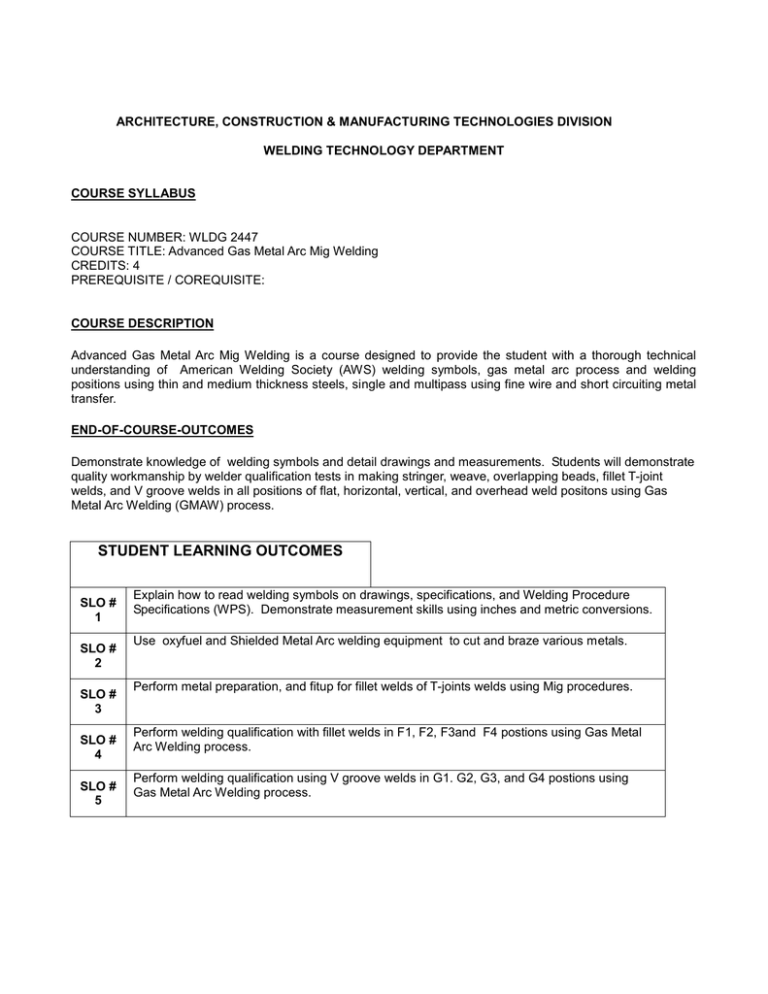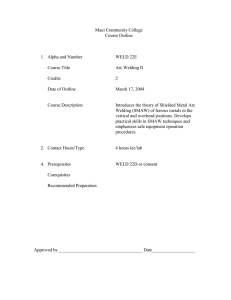GMAW Mig syllabus.doc
advertisement

ARCHITECTURE, CONSTRUCTION & MANUFACTURING TECHNOLOGIES DIVISION WELDING TECHNOLOGY DEPARTMENT COURSE SYLLABUS COURSE NUMBER: WLDG 2447 COURSE TITLE: Advanced Gas Metal Arc Mig Welding CREDITS: 4 PREREQUISITE / COREQUISITE: COURSE DESCRIPTION Advanced Gas Metal Arc Mig Welding is a course designed to provide the student with a thorough technical understanding of American Welding Society (AWS) welding symbols, gas metal arc process and welding positions using thin and medium thickness steels, single and multipass using fine wire and short circuiting metal transfer. END-OF-COURSE-OUTCOMES Demonstrate knowledge of welding symbols and detail drawings and measurements. Students will demonstrate quality workmanship by welder qualification tests in making stringer, weave, overlapping beads, fillet T-joint welds, and V groove welds in all positions of flat, horizontal, vertical, and overhead weld positons using Gas Metal Arc Welding (GMAW) process. STUDENT LEARNING OUTCOMES SLO # 1 SLO # 2 SLO # 3 SLO # 4 SLO # 5 Explain how to read welding symbols on drawings, specifications, and Welding Procedure Specifications (WPS). Demonstrate measurement skills using inches and metric conversions. Use oxyfuel and Shielded Metal Arc welding equipment to cut and braze various metals. Perform metal preparation, and fitup for fillet welds of T-joints welds using Mig procedures. Perform welding qualification with fillet welds in F1, F2, F3and F4 postions using Gas Metal Arc Welding process. Perform welding qualification using V groove welds in G1. G2, G3, and G4 postions using Gas Metal Arc Welding process. COURSE POLICIES Attendance Students are expected to attend classes regularly, and to be on time for every class period. Students can be dropped from a class due to excessive absences. Excessive tardiness may be considered absences. Students are responsible for subjects, assignments, and projects covered during their absences. Consult the Student Handbook for more details or visit http://www.hccs.edu/hccs/current-students/student-handbook Academic Honesty Scholastic dishonesty is treated with the utmost seriousness by the instructor and the College. Academic dishonesty includes, but it is not limited to the willful attempt to misrepresent one’s work, cheat, plagiarize, or impede other students’ scholastic progress. Consult the Student Handbook for more details. Students with Disabilities Any student with a documented disability (e.g. physical, learning, psychiatric, vision, hearing, etc.) who needs to arrange reasonable accommodations must contact the Disability Support Services Office at his / her respective college at the beginning of each semester. Faculties are authorized to provide only the accommodations requested by the Disability Support Services Office. For Central College, call 713 – 718 – 6164. Cell Phones All cell phones must be muted, set to vibrate, or turned off during class. Cell phone activity during class is deemed disruptive to the academic process and will not be tolerated. If you need to make or receive an emergency call, please leave the classroom. Calculators If the course allows the use of a calculator during class, lab projects, and exams, the student is responsible to bring his/her calculator. Cell phones are not calculators, and are not allowed to be used for that purpose during class, tests, or exams. Student ID Students are required to obtain a Student ID. For additional information, consult the Student Handbook. Parking Rules and Regulations Students are required to follow HCC’s regulations regarding parking and permits. For additional information, visit http://www.hccs.edu/hccs/about-hcc/police/parking/parking-rules-and-regulations Books, Tools and Supplies Students are required to purchase and bring to class the required textbooks, tools, notebooks, supplies, and writing instruments as required by the instructor. Dress Code Dress code must be appropriate for the class. Students must dress in a way that clothing and accessories do not compromise their safety, and the safety of others. Proper foot wear is required in all laboratories. Absolutely no sandals or other footwear that exposes the feet will be allowed. Classroom & Laboratory Conduct Proper behavior is expected in all classes and laboratories. Foul language and horseplay are not allowed. Making or receiving cell phone calls during class are not allowed. Sleeping in class is not allowed. Course Withdrawal It is the responsibility of the student to officially withdraw from a course before the official withdrawal deadline. A student who does not withdraw from a course by the deadline will receive an “F” as the final grade. Also note that under Section 51.907 of the Texas Education Code, an institution of higher education may not allow a student to drop more than six courses. COURSE OBJECTIVES Upon completion of this course, the student will: Explain how to read welding symbols on drawings, specifications, and Welding Procedure Specifications. Demonstrate the use of metric and inch measurement and conversions in weld drawings. Explain safety techniques for storing and handling cylinders. Demonstrate the use of oxyfuel cutting equipment Describe safety procedures for GMAW. Identify equipment and explain the filler metals and shielding gases used to perform GMAW. Demonstrate set up and use of GMAW equipment using multi-pass fillet and V-groove welds on carbon steel plate in various positions. COURSE TIMELINE, CONTENTS & ACTIVITIES WEEK # 1: COURSE RULES AND ORIENTATION Introduction Purpose of the course, textbook assignments Overview of course syllabus Course policies Required materials, textbook(s), supplies, and resources (if applicable) Disability Support Services Registration, schedules, receipts, and student ID, parking-rules-and-regulations. Importance of updating and maintaining student data (Name, Address, ID #, phone numbers, emails) Setting up welder certification with counselor Classroom and laboratory safety Course withdrawal, Official Day of Record, and last day for withdrawal Course tests, quizzes, exams, and assignments Course grading policies Instructor information Campus orientation Homework assignments WEEK # 2: Explain how to read symbols on drawings. Describe Lines, fills, object views, and dimensioning on drawings. Learn and demonstrate metric and inch measurement procedures and conversions used in welding industry. Learn welding positions. Take welding Safety test. Written Test chapter 1 Set up oxy fuel equipment, control torch flame, dissamble. Cut shapes from steel emphasing straight line, square shape, piercing. WEEK # 3: Explain physical characteristics and Mechanical Properties of Metals, Chapter 3 Establish a series of procedure steps to set-up, adjust and shut down gas metal arc welding equipment as a routine for on the job situations. Become familiar with machine adjustments and gun manipulations. Weld short beads on plate positioned flat on table. After approval, weld a pad of beads Written test, Chapter 2 WEEK # 4: Explain preheating interpass temperature control and postheating procedures, Chapter 4 Measure and Prepare metal to weld a T joint in F1 position. WrittenTest Chapter 3 WEEK # 5: Review procedures for GMAW. Identify FCAW equipment and the filler metals and shielding gases used, Chapter 5 Begin all postions T joint weld. Written Test Chapter 4 WEEK # 6: Explain set up and use of FCAW and GMAW equipment. Written Test Chapter 5 Continue qualification in all positions of T joint welds WEEK # 7: Blueprint and measurement procedures review. Chapter 7 Continue qualification welds according to AWS standards Produce quality square groove butt and fillet welds in flat position Written Test chapter 6 WEEK # 8: MIDTERM EXAM Midterm Exam, welding terminologies, symbols measurements qualification tests on T joint positions WEEK # 9: GTAW plate, Chapter 8 Continue weld qualification in all positions of flat, horizontal, vertical and overhead Written Test, Chapter 7 WEEK # 10: Review welding blueprint symbols and measurement procedures. Demonstrate groove welds with and without backing. Written Test chapter 8 WEEK # 11: Continue qualification test in all position welds Review of Measurement used on prints. Read a fractional inch, decimal inch and metric rule Review questions on measurements WEEK # 12: Weld V groove welds with backing in 1G, 2G 3G, and 4G positions Using welding prints, make calculations using fractions and decimals, Unit 3, Welding Print Measurements WEEK # 13: Weld open V-groove in 1G, 2G, 3G and 4G positions. Written Review, welding symbols WEEK # 14: Continue qualification tests on welds. Use bend test on welding Review Alphabet of Lines found on prints, Unit 4 WEEK # 15: Prepare for final written and performance exams WEEK # 16: FINAL EXAM Final Exam, welding terminologies Final exam, welding performance all positions, all weld techniques



